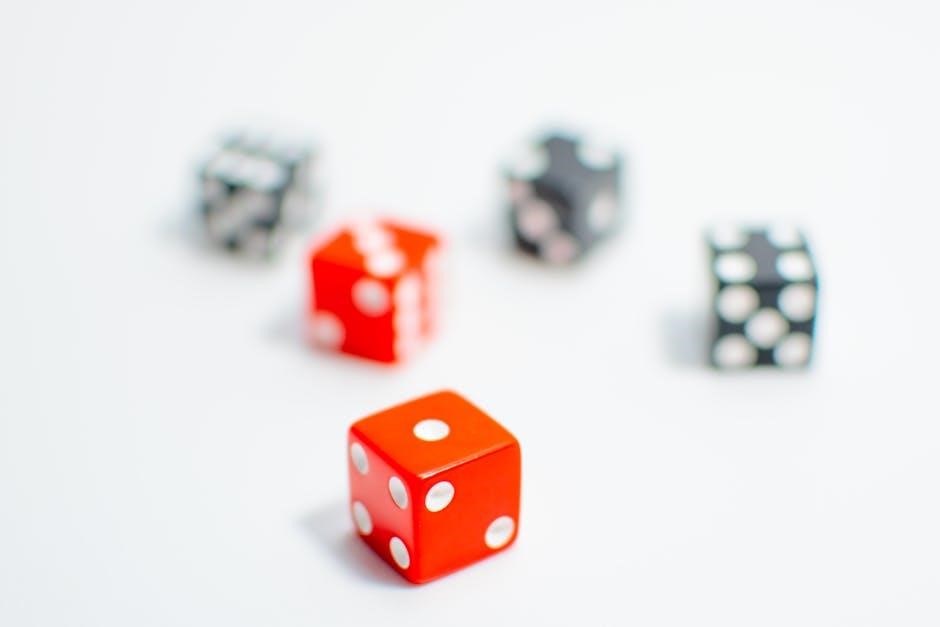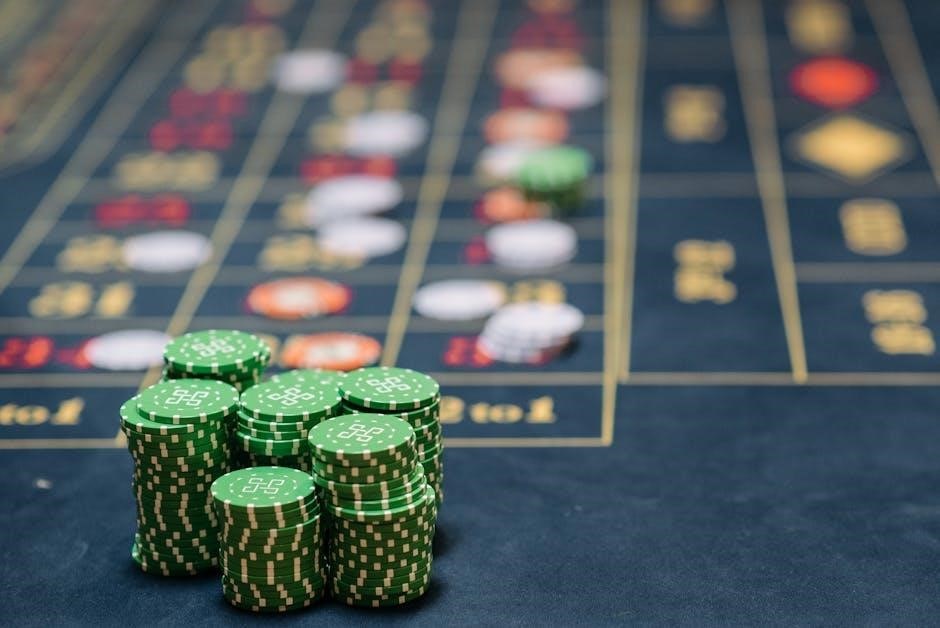Welcome to our comprehensive D&D Dice Guide! Whether you’re a new player or a seasoned adventurer, this guide will help you master the world of D&D dice. From understanding the basics to advanced tips, we’ll cover everything you need to know about these essential tools. Discover how dice shape your gameplay, explore their types, and learn how to use them effectively. This guide is your ultimate resource for enhancing your D&D experience and making every roll count.
1.1 What Are D&D Dice?
D&D dice are a set of polyhedral dice essential for determining outcomes in Dungeons & Dragons. A standard set includes seven dice: D4, D6, D8, D10, D12, D20, and D00. Each die has a unique number of sides, corresponding to its role in gameplay. These tools add randomness and excitement, shaping character actions, battles, and stories. They are more than just random number generators—they are the heart of D&D, influencing every decision and adventure in this immersive role-playing game.
1.2 Importance of Dice in D&D
Dice are central to Dungeons & Dragons, serving as the primary mechanism for resolving conflicts, determining outcomes, and driving the game’s narrative. They introduce randomness and unpredictability, making each session unique. From attack rolls to skill checks, dice decide the success or failure of actions, creating tension and excitement. Beyond mechanics, they become a storytelling tool, shaping characters’ fates and the world’s evolution. Dice are not just random number generators—they are the lifeblood of D&D, ensuring every decision carries weight and every roll feels meaningful.
Types of D&D Dice
D&D dice include seven polyhedral dice: D4, D6, D8, D10, D12, D20, and D00. Each die serves unique roles in gameplay, offering a range of outcomes for diverse scenarios.
2.1 D4 (Four-Sided Die)
The D4, or four-sided die, is used for determining small damage rolls and minor spell effects. Its pyramid-like shape ensures each face has an equal chance of landing face up. Commonly, it’s used in scenarios requiring subtle outcomes, such as additional effects of certain spells or minor weapon damage. The D4’s unique design makes it a versatile tool for specific in-game mechanics, adding a layer of unpredictability to your adventures. Its simplicity and functionality make it a staple in every D&D dice set.
2.2 D6 (Six-Sided Die)
The D6, or six-sided die, is a cornerstone of D&D gameplay. Its cube shape ensures balanced rolls, making it ideal for weapon damage, skill checks, and character stats. Commonly used in many board games, the D6 is familiar to most players. In D&D, it’s essential for determining outcomes like weapon damage, skill checks, and character stats. Its versatility and reliability make it a go-to die for various game mechanics, ensuring fair and consistent results. Whether you’re a beginner or a veteran, the D6 is indispensable for shaping your D&D adventures.
2.3 D8 (Eight-Sided Die)
The D8, or eight-sided die, is a versatile tool in D&D gameplay. Its eight triangular faces provide a balanced range of outcomes, making it ideal for medium weapon damage and spells. Resembling two pyramids joined at the base, the D8 ensures fair and consistent rolls. Whether determining damage for a weapon or resolving spell effects, the D8 is a reliable choice for various in-game scenarios. Its moderate range offers flexibility, making it a valuable addition to any player’s dice set for shaping engaging and dynamic adventures.
2.4 D10 (Ten-Sided Die)
The D10, or ten-sided die, is a versatile die used for damage rolls, skill checks, and generating percentages. It features a pentagonal trapezohedron shape, ensuring balanced rolls. Often paired with a D100 for percentile outcomes, the D10 allows for precise probability determination; Its wide range of numbers makes it ideal for resolving complex scenarios, such as high-damage spells or unique game mechanics. Whether for damage calculations or random events, the D10 is a crucial tool for adding depth and variety to your D&D gameplay.
2.5 D12 (Twelve-Sided Die)
The D12, with its twelve pentagonal faces, is a powerful die used for heavy weapon damage and higher-level spells. Its unique shape ensures fair rolls, making it ideal for significant impacts in the game. Commonly used for resolving powerful attacks or magical effects, the D12 adds depth to gameplay. Its larger range allows for dramatic outcomes, making it a staple for players seeking to unleash devastating abilities. Whether for epic battles or intricate spellcasting, the D12 is a key tool for shaping your character’s influence in the world of D&D.
2.6 D20 (Twenty-Sided Die)
The D20 is the most iconic die in D&D, used for attack rolls, saving throws, and skill checks. Its twenty triangular faces provide a wide range of outcomes, determining success or failure. A roll of 1 can spell disaster, while a 20 often brings triumph; The D20’s spherical shape ensures balanced rolls, making it a fair and unpredictable tool. Crucial for shaping character fate, the D20 is central to the game’s excitement and unpredictability, influencing every major decision and action in the world of Dungeons & Dragons.
2.7 D00 (Percentile Die)
The D00, or percentile die, is essential for generating values between 1 and 100. Used alongside a D10, it allows for precise percentile rolls, perfect for skill checks, abilities, and random events. Labeled from 00 to 90, the D00 adds versatility to your gameplay, enabling nuanced outcomes in character development and storytelling. This die is a must-have for advanced mechanics and enhances your ability to create dynamic, unpredictable scenarios in Dungeons & Dragons.

Choosing the Right Dice Set
Choosing the right dice set is crucial for enhancing your D&D experience. Consider materials, customization options, and themes to find a set that matches your style and gameplay needs. Explore various designs and prioritize quality to ensure fair and consistent rolls, making every adventure memorable and immersive. Your dice set is more than a tool—it’s a gateway to endless possibilities in your D&D journey.
3.1 Materials for D&D Dice
D&D dice are crafted from a variety of materials, each offering unique qualities. Plastic dice are durable and affordable, making them ideal for beginners. Metal dice provide a premium feel and weight, appealing to seasoned players. Resin dice often feature intricate designs and vibrant colors, while stone dice add a luxurious touch. Each material impacts the rolling experience, with plastic being lightweight and metal offering a satisfying heft; Choose a material that suits your style and enhances your gameplay, ensuring a blend of functionality and personal preference.
3.2 Customizing Your Dice Set
Customizing your D&D dice set allows you to add a personal touch to your gameplay. From unique engravings to vibrant color schemes, customization options are endless. You can choose dice that match your character’s theme or opt for glow-in-the-dark sets for added flair. Some players even mix and match dice from different sets to create a truly one-of-a-kind collection. Customization not only enhances the visual appeal of your dice but also makes them feel truly yours, adding a personal connection to your D&D experience.
3.3 Themed Dice for Immersive Play
Themed dice sets can elevate your D&D experience by immersing you in the game’s world. Whether it’s medieval-inspired designs, dragon-scale patterns, or glow-in-the-dark sets, themed dice enhance the storytelling aspect of your adventures. They allow players to connect with their characters and campaigns on a deeper level. For example, a fantasy-themed set with mystical symbols can add an extra layer of enchantment to your rolls. Themed dice not only personalize your gameplay but also serve as a visual reminder of the unique narratives unfolding at the table.
How to Use D&D Dice
D&D dice are central to gameplay, injecting randomness and excitement. Each die type serves specific purposes, from attack rolls to skill checks. Mastering their use enhances your adventure.
4.1 Reading Dice Rolls for Beginners
Reading D&D dice rolls is straightforward once you understand the basics. Each die has numbered faces, and the number it lands on determines the outcome. For example, a D6 (six-sided die) can roll a number between 1 and 6. The D20 (twenty-sided die) is used for skill checks and attacks, with higher numbers indicating success. Always clean your hands before rolling to ensure fairness. Use a dice tray to contain the roll and interpret the number based on the die’s faces. This simple process is the heart of D&D gameplay.
4.2 Common Uses for Each Die Type
Each die type serves a specific role in D&D gameplay. The D20 is used for skill checks, attacks, and critical hits, while the D6 is common for weapon damage and character stats. The D4 is ideal for minor spells and small damage rolls, and the D8 balances medium-range outcomes. The D10 and D12 are often used for larger damage calculations, while the D100 (or D%) determines percentages for skill successes or failures. Understanding these uses helps players apply the right die in any situation, ensuring smooth and dynamic gameplay.

Advanced Dice Tips
Elevate your gameplay with expert strategies like using multiple dice for advantage/disadvantage rolls and creating custom dice for unique mechanics. These tips enhance your D&D experience.
5.1 Using Multiple Dice for Advantage/Disadvantage Rolls
Enhance your gameplay by mastering the art of rolling with advantage or disadvantage. When rolling with advantage, use two dice of the same type, such as two D20s, and choose the higher result. Conversely, for disadvantage, select the lower result. This mechanic adds depth to encounters, allowing for strategic decisions. For example, a rogue might use advantage to sneak past guards, while a wizard faces disadvantage when casting in a storm. Properly using multiple dice can turn the tide of any scenario, ensuring dynamic and unpredictable outcomes in your D&D adventures.
5.2 Custom Dice for Unique Game Mechanics
Elevate your D&D experience with custom dice tailored to unique game mechanics. Engraved or painted dice can represent specific abilities, such as a critical hit die or a magic effect die. Some players use glow-in-the-dark dice for night-based campaigns, while others opt for themed sets that match their character’s backstory. Custom dice can also streamline complex rules, like using a D12 for tracking initiative or a D100 for custom skill systems. These specialized tools add a personal touch and enhance immersion, making your game truly one-of-a-kind.
Dice Care and Maintenance
Properly caring for your D&D dice ensures longevity and fairness. Clean them with mild soap, store in protective cases, and avoid harsh chemicals. Regularly inspect for damage and use trays to prevent scratches. This maintains their balance and appearance, ensuring every roll remains true to your adventures.
6.1 Cleaning and Storing Dice
Proper cleaning and storage are crucial for maintaining your D&D dice. Clean your dice with mild soap and a soft cloth to remove dirt and oils. Avoid harsh chemicals or abrasive materials that could damage the surfaces. Store your dice in a protective case or pouch to prevent scratches and chips. For added protection, use a dice bag or tray. Regularly cleaning and storing your dice ensures they remain balanced and in excellent condition for years of reliable gameplay.
6.2 Using Dice Trays and Towers
Dice trays and towers are excellent accessories for organizing and protecting your D&D dice. Trays provide a cushioned surface for rolling, preventing damage and keeping dice contained. Towers add drama by funneling dice through a series of levels, ensuring randomization. Both options enhance gameplay by reducing noise and prolonging the life of your dice. Choose a design that matches your style to keep your dice safe, organized, and ready for your next adventure.
6.4 When to Replace Your Dice
Replace your D&D dice when they show significant wear or no longer roll fairly. Inspect for scratches, chips, or cracks that could affect balance. If a die frequently lands on the same number or wobbles, it’s time for a new one. High-quality dice are an investment in your game’s integrity. Regular checks ensure your dice remain accurate and reliable, keeping your adventures fair and enjoyable. Don’t hesitate to upgrade when needed to maintain the best gameplay experience.

The Role of Dice in Shaping Your D&D Experience
Dice are the heart of D&D, bringing unpredictability and excitement to every roll. They shape the narrative, create unforgettable moments, and add drama to your adventures, making each session unique.
7.1 Game-Changing Rolls and Their Impact
A single roll can transform a D&D game. A critical hit or miss can shift the tide of battle, while a high or low skill check can alter the story’s direction. These pivotal moments create lasting memories, as players and DMs alike recall the thrill or agony of such outcomes. The unpredictability of dice ensures that no two sessions are ever the same, making every roll a potential game-changer that leaves a lasting impact on your campaign.
7.2 Dice as a Storytelling Tool
Dice are more than random number generators; they are storytellers. Each roll weaves unpredictability into the narrative, creating moments of triumph, despair, and surprise. A critical hit or a failed save can spark unexpected twists, shaping the story in ways no one anticipated. The dice’s randomness becomes the canvas for epic tales, memorable characters, and legendary adventures. They empower both players and DMs to collaborate in crafting a unique story, making every roll a brushstroke in the ever-unfolding saga of your D&D campaign.
